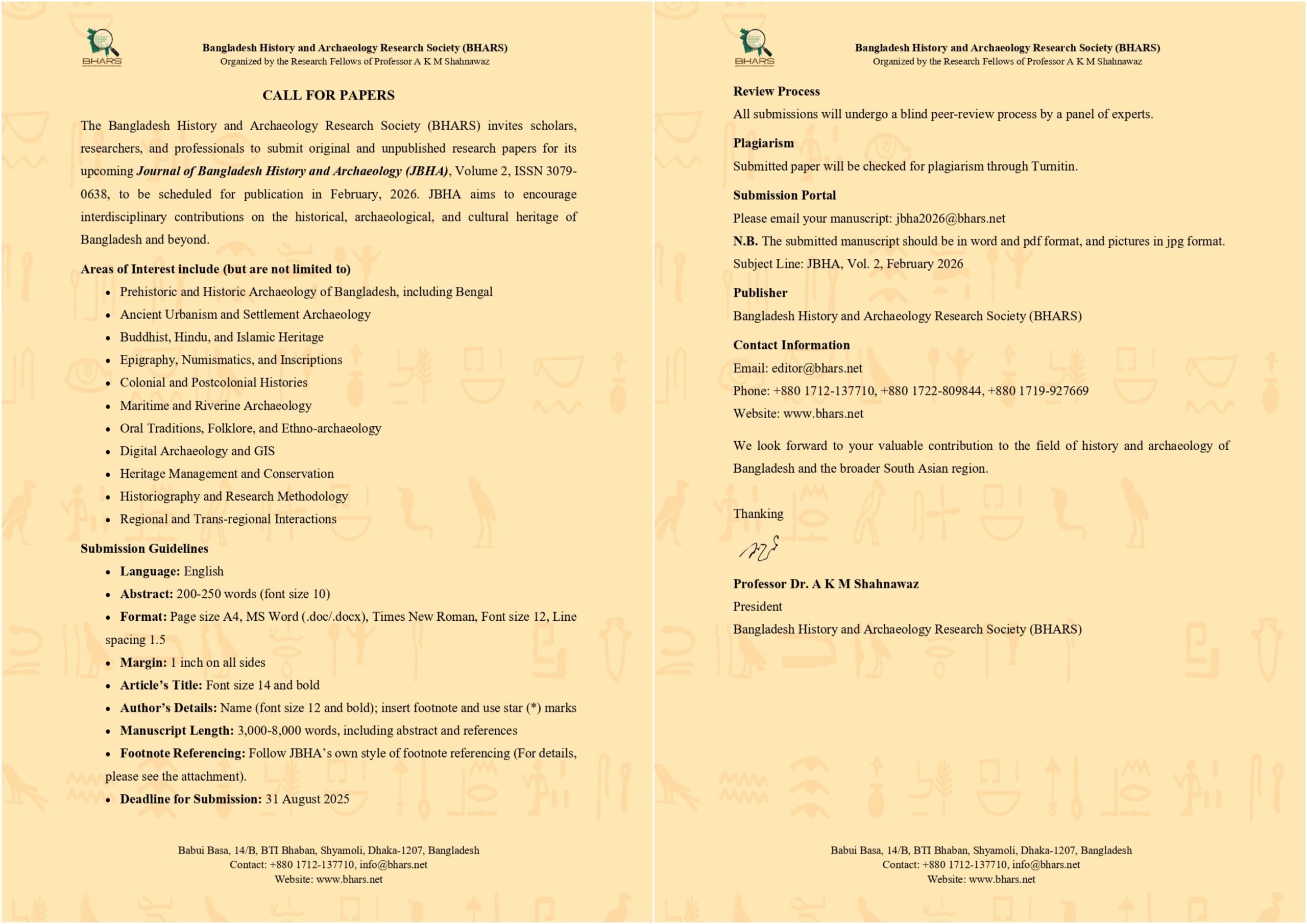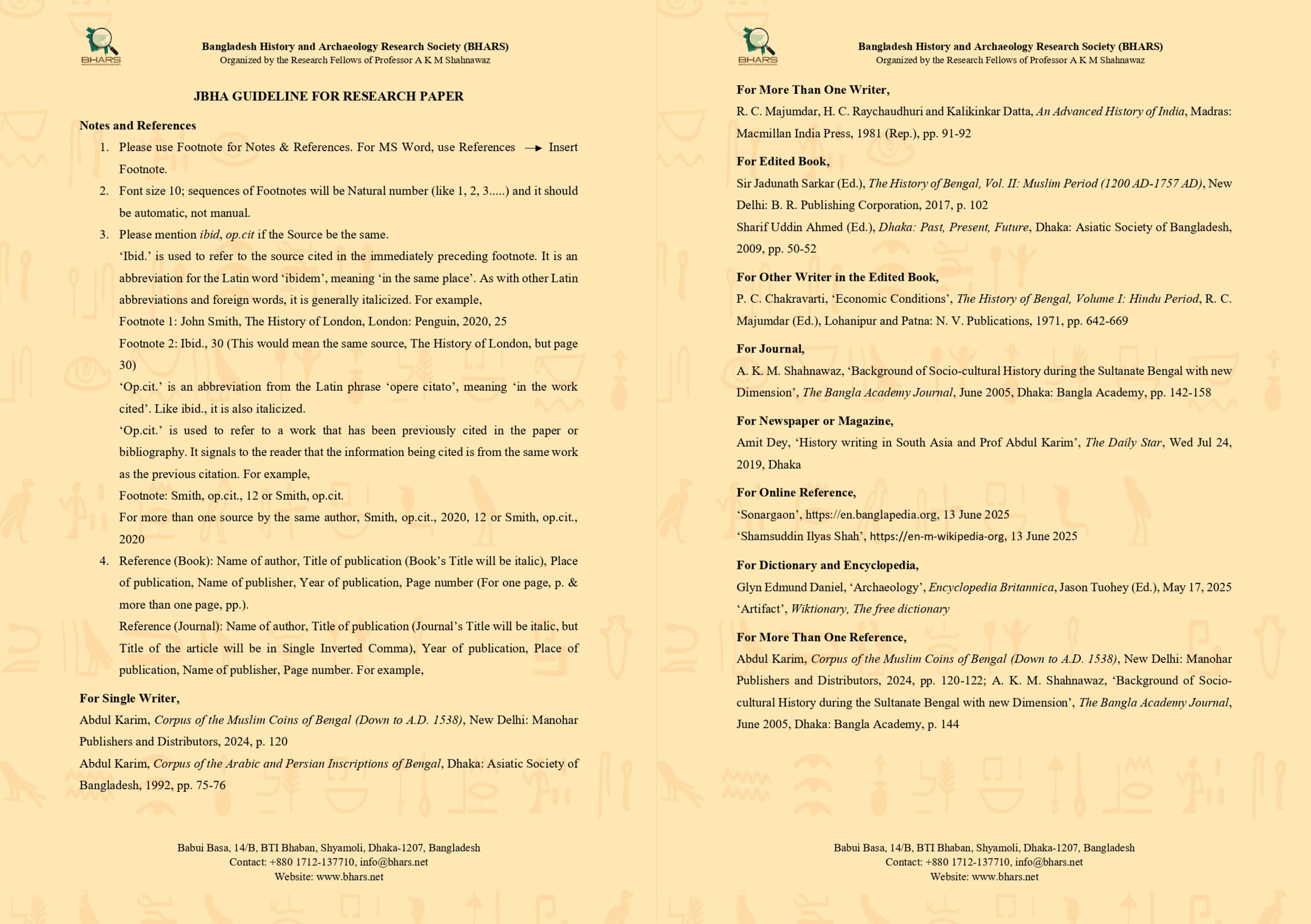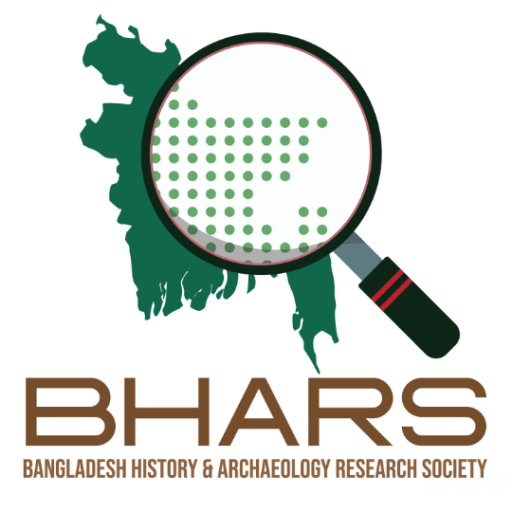Journal of Bangladesh History and Archaeology (JBHA)
https://doi.org/10.64853/jbha
The Journal of Bangladesh History and Archaeology (JBHA) is a peer-reviewed academic journal published by the Bangladesh History and Archaeology Research Society (BHARS). It is dedicated to the advancement of research in the fields of archaeology, history, heritage studies, and related disciplines focused on Bangladesh and the South Asian region.
JBHA serves as a scholarly platform for both emerging and established researchers to present their original work, including research articles, field reports, and critical reviews. The journal aims to bridge the gap between field-based discoveries and academic discourse, encouraging interdisciplinary engagement and public understanding of cultural heritage.
Key Features:
-
Open-access and non-profit
-
Publishes in English.
-
Double-blind peer review process
-
Contributions from national and international scholars
JBHA is committed to preserving the past and enriching the future through academic excellence.


CALL FOR PAPERS
The Bangladesh History and Archaeology Research Society (BHARS) invites scholars, researchers, and professionals to submit original and unpublished research papers for its upcoming Journal of Bangladesh History and Archaeology (JBHA), Volume 2, ISSN 3079-0638, to be scheduled for publication in February, 2026. JBHA aims to encourage interdisciplinary contributions on the historical, archaeological, and cultural heritage of Bangladesh and beyond.
Areas of Interest include (but are not limited to)
- Prehistoric and Historic Archaeology of Bangladesh, including Bengal
- Ancient Urbanism and Settlement Archaeology
- Buddhist, Hindu, and Islamic Heritage
- Epigraphy, Numismatics, and Inscriptions
- Colonial and Postcolonial Histories
- Maritime and Riverine Archaeology
- Oral Traditions, Folklore, and Ethno-archaeology
- Digital Archaeology and GIS
- Heritage Management and Conservation
- Historiography and Research Methodology
- Regional and Trans-regional Interactions
Submission Guidelines
- Language: English
- Abstract: 200-250 words (font size 10)
- Format: Page size A4, MS Word (.doc/.docx), Times New Roman, Font size 12, Line spacing 1.5
- Margin: 1 inch on all sides
- Article’s Title: Font size 14 and bold
- Author’s Details: Name (font size 12 and bold); insert footnote and use star (*) marks
- Manuscript Length: 3,000-8,000 words, including abstract and references
- Footnote Referencing: Follow JBHA’s own style of footnote referencing (For details, please see the attachment).
- Deadline for Submission: 31 August 2025
Review Process
All submissions will undergo a blind peer-review process by a panel of experts.
Plagiarism
Submitted paper will be checked for plagiarism through Turnitin.
Submission Portal
Please email your manuscript: jbha2026@bhars.net
N.B. The submitted manuscript should be in word and pdf format, and pictures in jpg format.
Subject Line: JBHA, Vol. 2, February 2026
Publisher
Bangladesh History and Archaeology Research Society (BHARS)
Contact Information
Email: editor@bhars.net
Phone: +880 1712-137710, +880 1722-809844, +880 1719-927669
Website: www.bhars.net
We look forward to your valuable contribution to the field of history and archaeology of Bangladesh and the broader South Asian region.
Thanking
Professor Dr. A K M Shahnawaz
President
Bangladesh History and Archaeology Research Society (BHARS)
JBHA GUIDELINE FOR RESEARCH PAPER
Notes and References
- Please use Footnote for Notes & References. For MS Word, use References Insert Footnote.
- Font size 10; sequences of Footnotes will be Natural number (like 1, 2, 3…..) and it should be automatic, not manual.
- Please mention ibid, cit if the Source be the same.
‘Ibid.’ is used to refer to the source cited in the immediately preceding footnote. It is an abbreviation for the Latin word ‘ibidem’, meaning ‘in the same place’. As with other Latin abbreviations and foreign words, it is generally italicized. For example,
Footnote 1: John Smith, The History of London, London: Penguin, 2020, 25
Footnote 2: Ibid., 30 (This would mean the same source, The History of London, but page 30)
‘Op.cit.’ is an abbreviation from the Latin phrase ‘opere citato’, meaning ‘in the work cited’. Like ibid., it is also italicized.
‘Op.cit.’ is used to refer to a work that has been previously cited in the paper or bibliography. It signals to the reader that the information being cited is from the same work as the previous citation. For example,
Footnote: Smith, op.cit., 12 or Smith, op.cit.
For more than one source by the same author, Smith, op.cit., 2020, 12 or Smith, op.cit., 2020
- Reference (Book): Name of author, Title of publication (Book’s Title will be italic), Place of publication, Name of publisher, Year of publication, Page number (For one page, p. & more than one page, pp.).
Reference (Journal): Name of author, Title of publication (Journal’s Title will be italic, but Title of the article will be in Single Inverted Comma), Year of publication, Place of publication, Name of publisher, Page number. For example,
For Single Writer,
Abdul Karim, Corpus of the Muslim Coins of Bengal (Down to A.D. 1538), New Delhi: Manohar Publishers and Distributors, 2024, p. 120
Abdul Karim, Corpus of the Arabic and Persian Inscriptions of Bengal, Dhaka: Asiatic Society of Bangladesh, 1992, pp. 75-76
For More Than One Writer,
- C. Majumdar, H. C. Raychaudhuri and Kalikinkar Datta, An Advanced History of India, Madras: Macmillan India Press, 1981 (Rep.), pp. 91-92
For Edited Book,
Sir Jadunath Sarkar (Ed.), The History of Bengal, Vol. II: Muslim Period (1200 AD-1757 AD), New Delhi: B. R. Publishing Corporation, 2017, p. 102
Sharif Uddin Ahmed (Ed.), Dhaka: Past, Present, Future, Dhaka: Asiatic Society of Bangladesh, 2009, pp. 50-52
For Other Writer in the Edited Book,
- C. Chakravarti, ‘Economic Conditions’, The History of Bengal, Volume I: Hindu Period, R. C. Majumdar (Ed.), Lohanipur and Patna: N. V. Publications, 1971, pp. 642-669
For Journal,
- K. M. Shahnawaz, ‘Background of Socio-cultural History during the Sultanate Bengal with new Dimension’, The Bangla Academy Journal, June 2005, Dhaka: Bangla Academy, pp. 142-158
For Newspaper or Magazine,
Amit Dey, ‘History writing in South Asia and Prof Abdul Karim’, The Daily Star, Wed Jul 24, 2019, Dhaka
For Online Reference,
‘Sonargaon’, https://en.banglapedia.org, 13 June 2025
‘Shamsuddin Ilyas Shah’, https://en-m-wikipedia-org, 13 June 2025
For Dictionary and Encyclopedia,
Glyn Edmund Daniel, ‘Archaeology’, Encyclopedia Britannica, Jason Tuohey (Ed.), May 17, 2025
‘Artifact’, Wiktionary, The free dictionary
For More Than One Reference,
Abdul Karim, Corpus of the Muslim Coins of Bengal (Down to A.D. 1538), New Delhi: Manohar Publishers and Distributors, 2024, pp. 120-122; A. K. M. Shahnawaz, ‘Background of Socio-cultural History during the Sultanate Bengal with new Dimension’, The Bangla Academy Journal, June 2005, Dhaka: Bangla Academy, p. 144
